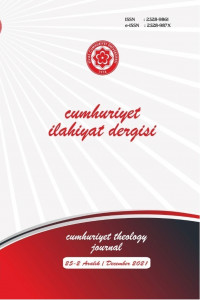Ses Esaslı Okuma Yazma Öğretimi Yöntemi ile Kur’an Öğretiminin İmkânı: Ses Temelli Elifbâ Örneği
The Possibility of Teaching the Qurʾān with Sound Based Reading and Writing Teaching Method: The Example of Sound Based Alif ba
Author(s): Hatice AyarSubject(s): Theology and Religion, Islam studies, Distance learning / e-learning
Published by: Cumhuriyet Üniversitesi İlahyat Fakültesi
Keywords: Religious Education; Qurʾān Teaching; Alif ba Teaching; Sound-Based Alif Ba Method; Distance Learning;
Summary/Abstract: The Qurʾān was taught in the letter method for many years. After the names of the letters in the Arabic alphabet are memorized in this method, the teaching of origins and signs begins. The syllabic method was developed over time as an alternative to this method, and the letters were taught directly with their superior vowel signs without memorizing their names. Unlike these two methods, the sound-based alif ba method has begun to be used in recent years. This method coincides with the primary literacy teaching method based on the sounds thatwere adopted in Turkish teaching since 2005. Basic principles such as teaching the letters one-by-one, following the sound learning stages in teaching each sound, conducting the lessons in class, reading the syllables and words formed with the learned letters from the first day are adopted in both teaching methods. The purpose of the present study was to find out how the Qurʾān can be taught by applying the sound-based alif ba method and to draw attention to the original aspects of this method for learning the Qurʾān with the right sounds. Since the correct teaching of the Qurʾān is closely related to the teacher’s content knowledge and teaching skills, the alif ba that will be used and the method to be applied are important in reaching the target more systematically and faster. The case study design was used in the study in which the qualitative method was employed. The primary data of the study were Sound-Based Alif ba, for which I was the project assistant of, and the book with the title A New Approach in Teaching the Qurʾān: Sound based Alif baand Tajwīd Method, which was an editorial book of which I was one of the authors, and the thirty-episode series We Are Children and We Are Reading the Qurʾān, published on Diyanet TV, for which I was the production coordinator. Also, to see the applicability of the method, interviews were conducted with eight instructors who used Sound-Based Alif ba in their lessons. The study received ethical approval from Ankara Social Sciences University Rectorate Social and Human Sciences Research and Scientific Publication Ethics Committee on 8 July 2021 with the decision no 12450. The main thing in the sound-based alif ba method is the correct vocalization of the Qurʾān. The letters in alif ba are arranged differently from the classical alphabet order and are divided into six groups considering the frequency of occurrence in the Qurʾān and the degree of difficulty of origins. Each letter is taught in a separate lesson with the support of the ḥarakas and the sukūn (such as اَلْ, اِلْ, اُلْ). During the teaching, attention is paid to the sound learning steps, and the student is expected to feel the sound of the letter to be learned, distinguish it from other letter sounds, and then pronounce it from the correct origin as much as possible. In the sound-based alif ba method, the teaching of the shape of the letter is done after the sound of the letter is pronounced. During the teaching of the shapes of the letters, the part of the letter that does not change when written within a word is emphasized, and the writing is used so that the shape of the letter can be placed in the mind of the student. In the sound-based alif ba teaching, reading from the Qurʾān is done in every lesson, starting from the teaching of the first letter. During the teaching of alif ba, educational games, question-answer, and narration methods are used, primarily with the taʿlīm method. In this way, the teaching of Sound-Based Alif ba is spread over a period of 40 lessons. The study findings showed that the sound-based alif ba method has similar characteristics with the sound-based primary literacy teaching method; however, Arabic has its own unique aspects with its language structure. Among these originalities, which is adopted in the teaching of letters, firstly teaching the letter with the sukūn and with the support of movable ا and then showing the shape of the letter is carried out. As a matter of fact, the teachers have the opinion that this vocalization method, which is adopted, facilitates the learning of the correct sounds, and that teaching the letters in line with the sound learning steps increases the efficiency of the lesson. Although most of the instructors pointed out to the positive aspects of teaching tajwīd sounds in alif ba, one of the instructors did not find it necessary. The opinions of the teachers showed that the sound-based alif ba method can be applied efficiently in online lessons, but the teacher-student relation is affected negatively when compared to the classroom setting. All of the instructors said that the materials used in the lessons and demonstration and educational game methods increased the quality of the course, and that the We Are Children We Are Reading the Qurʾān program is an important resource for them.
Journal: Cumhuriyet İlahiyat Dergisi
- Issue Year: 25/2021
- Issue No: 2
- Page Range: 561-582
- Page Count: 22
- Language: Turkish

